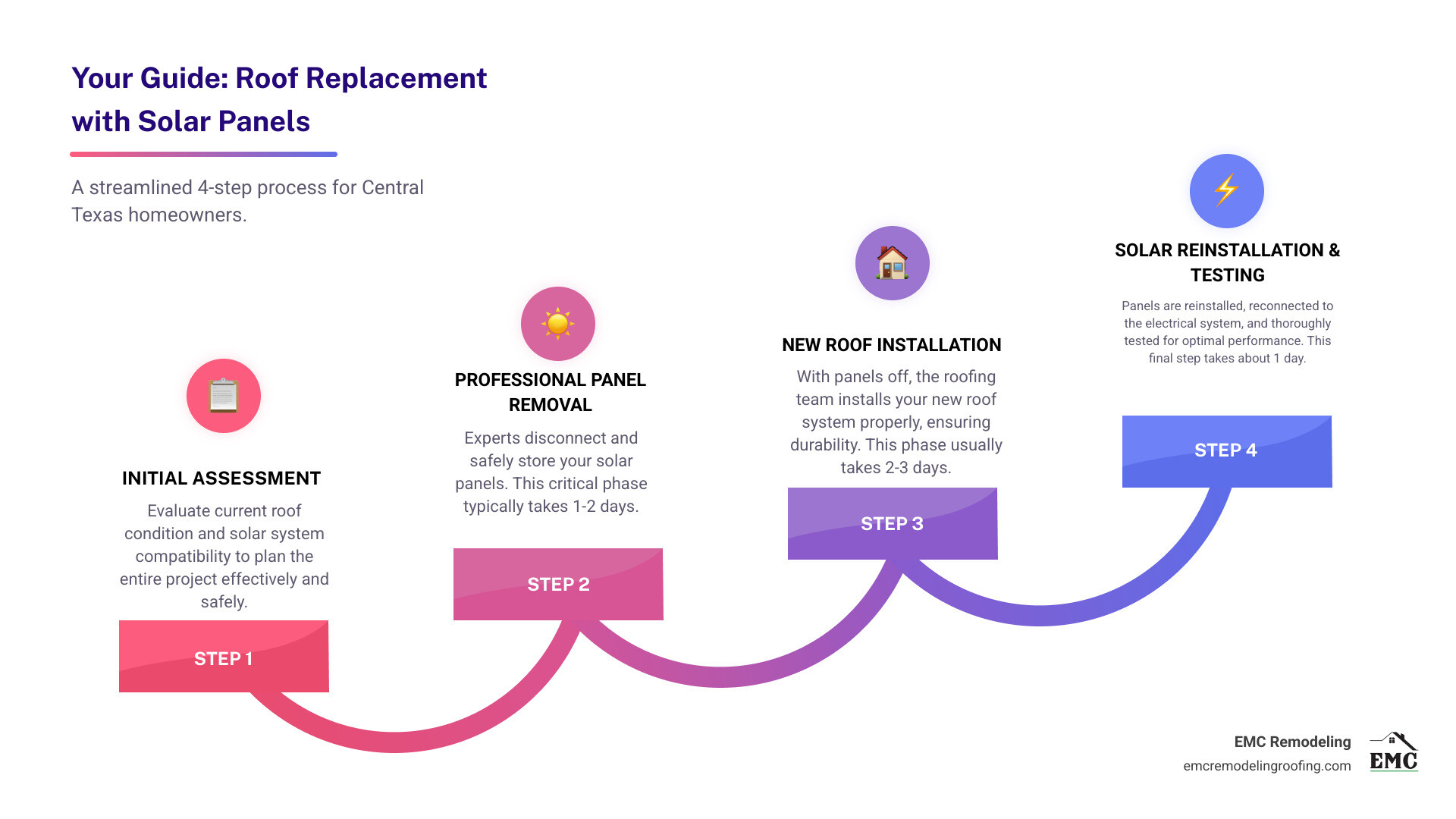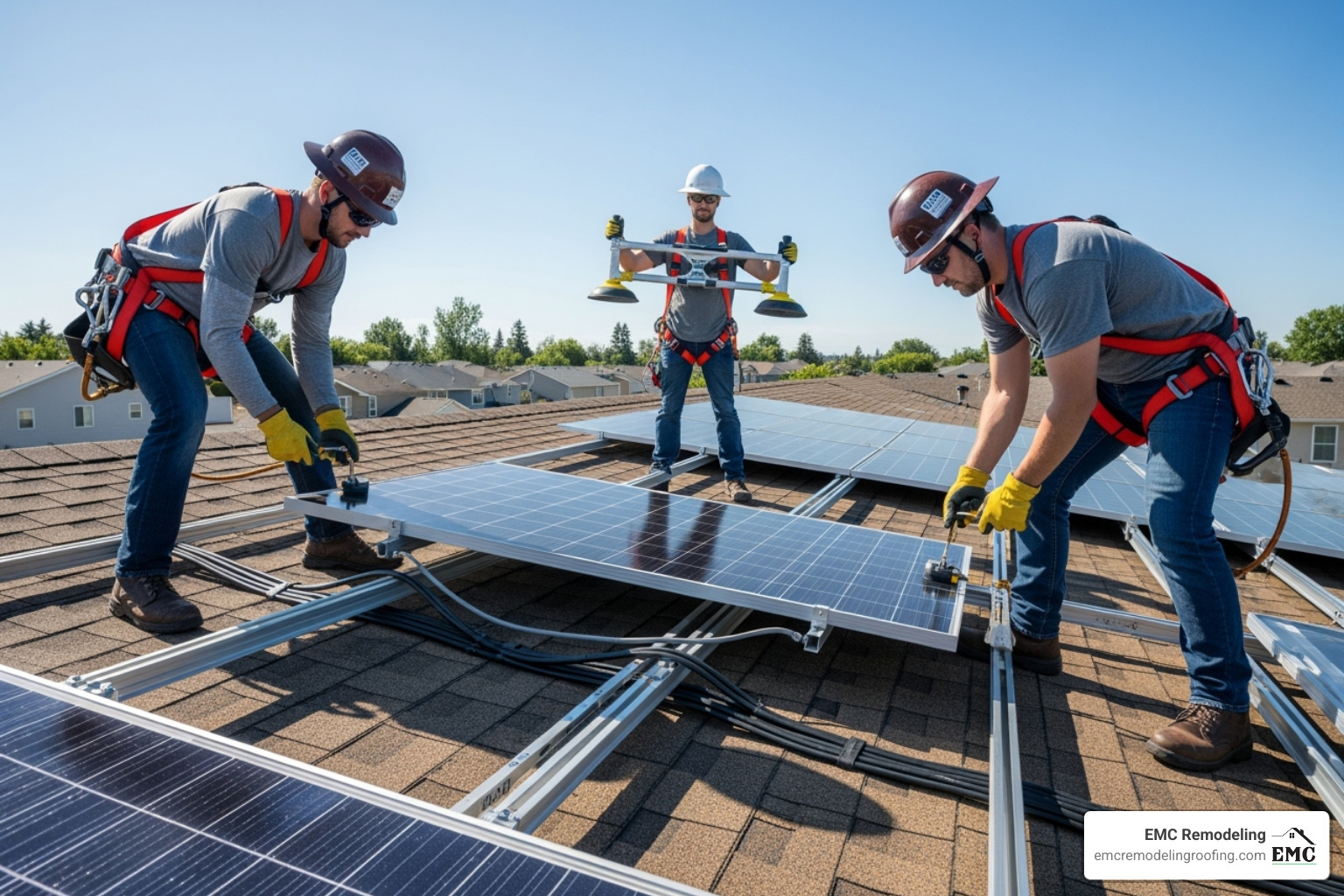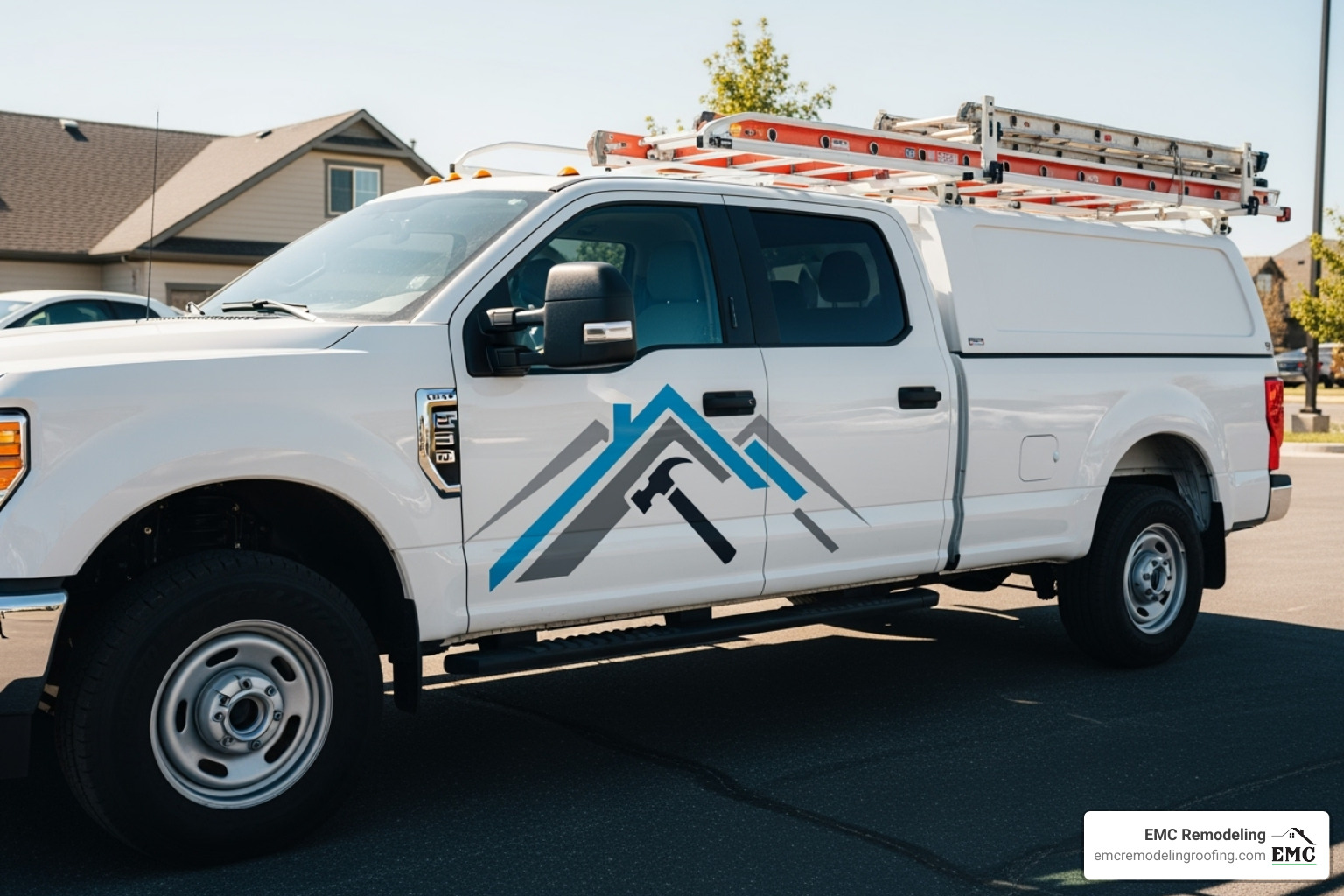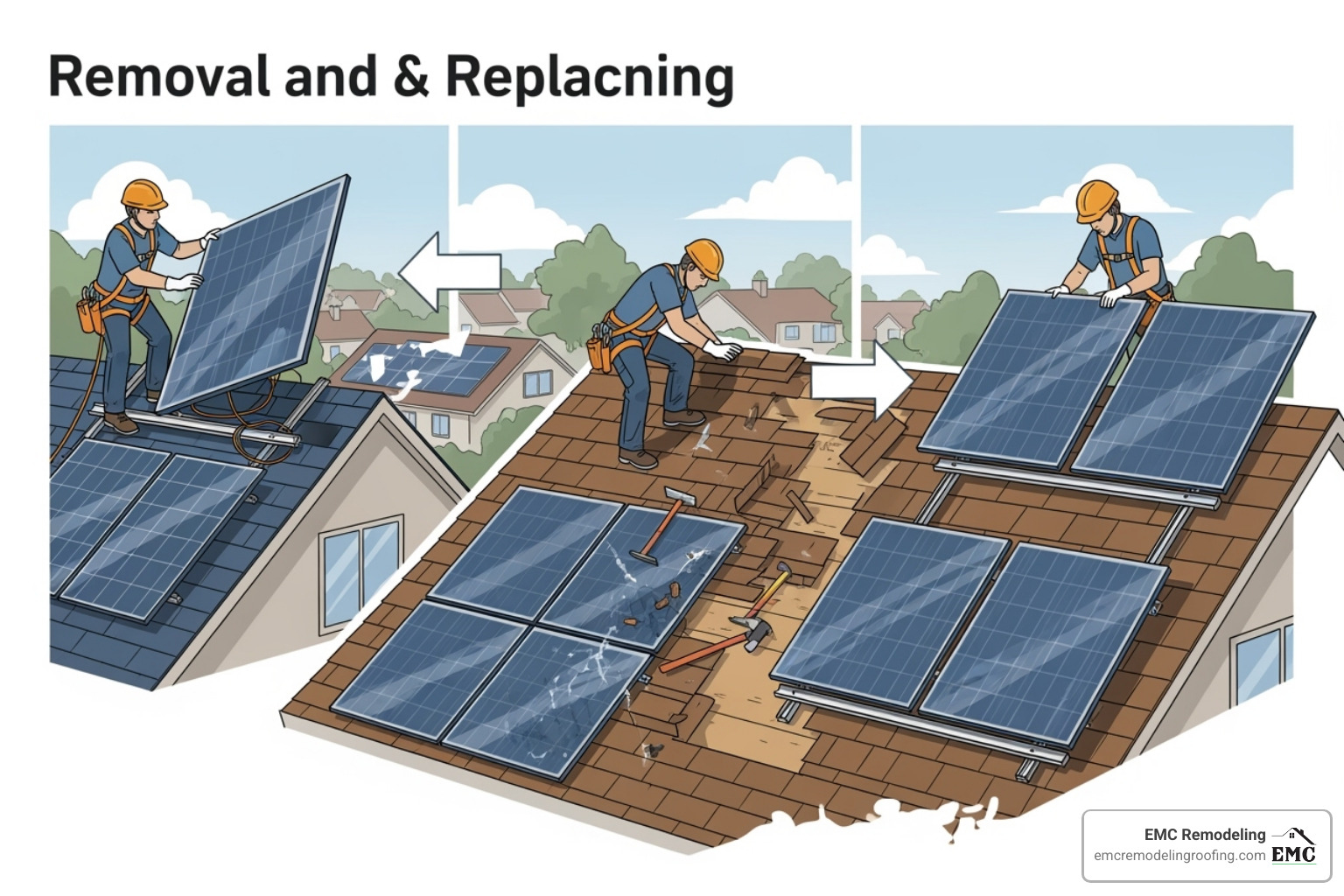Why Solar Panel Removal Is Essential for Roof Replacement Success
When you need to remove solar panels to replace roof systems, you’re facing a complex but manageable home improvement challenge. Here’s a quick overview for Central Texas homeowners:
The Process at a Glance:
- Assessment: Evaluate roof condition and solar system compatibility.
- Professional Removal: Disconnect and safely store panels (1-2 days).
- Roof Replacement: Install new roofing materials (2-3 days).
- Reinstallation: Reconnect and test the solar system (1 day).
- Cost Range: Expect $200-$500 per panel for removal and reinstallation.
Solar panels last 25-30 years, but the asphalt shingle roof underneath often needs replacement after 15-20 years. When it’s time, coordinating both projects is crucial for protecting your investment.
The process requires electrical expertise, specialized equipment, and careful coordination. DIY removal risks voiding warranties, damaging expensive equipment, and creating serious safety hazards.
For Central Texas homeowners dealing with hail and intense sun, timing your roof replacement correctly saves money and ensures your solar investment keeps performing. I’m Matt Runyon, President of EMC Remodeling & Roofing. With over 15 years of experience, our team has coordinated dozens of these dual projects, protecting our clients’ roofing and solar investments throughout the process.

When is Solar Panel Removal Necessary for a Roof Replacement?
In almost all cases, you need to remove solar panels to replace roof systems completely. While your panels can last 25-30 years, an asphalt shingle roof in Central Texas typically needs replacement after 15-20 years. This creates a “solar-roof gap” that most homeowners will eventually face.
Key warning signs that it’s time for a roof replacement include:
- Curled, cupped, or missing shingles
- Widespread granule loss creating bare spots
- Water stains or leaks inside your home
- A sagging roofline
Central Texas weather, with its intense UV exposure and hail storms, accelerates roof deterioration. When you see these signs, acting quickly is crucial. Your solar panels are only as secure as the roof they’re mounted on; a failing roof compromises your home’s protection and your solar investment.
Understanding Your Roof and Mounting System
Before work begins, a professional assessment of your roof and solar mounting system is needed. Most Central Texas homes have asphalt shingle roofs with panels attached using penetrating mounts. These mounts bolt through the shingles into the roof deck, requiring expert flashing and sealing to prevent leaks.
Metal roofs may use clamp-based systems that grip seams without penetration, simplifying removal. However, some still use penetrating mounts. The complexity also depends on the system’s age and components, like micro-inverters, which require more detailed electrical work.
Assessing the roof deck is also critical. Any soft spots or water damage found after panel removal must be addressed before the new roof is installed.
Partial vs. Complete Removal: Making the Right Call
Can you just remove some of the panels? For minor, isolated repairs, partial removal might be an option. We can detach only the panels over the repair area, fix the issue, and reinstall them.
However, a full roof replacement almost always requires complete panel removal. Attempting to work around panels compromises the project by:
- Limiting Access: Prevents proper inspection and installation of new underlayment and shingles.
- Creating Safety Risks: Crews need an unobstructed workspace to operate safely and efficiently.
- Voiding Warranties: Improper installation techniques can void your new roof’s warranty.
- Reducing Quality: Work done in cramped spaces around expensive equipment rarely meets professional standards.
Shortcuts lead to leaks and costly future repairs. For a full roof replacement, complete panel removal is the only way to protect both your roofing and solar investments for the long term.
The Step-by-Step Process: From Takedown to Power-Up
When it’s time to remove solar panels to replace roof, the project requires a careful blend of electrical and roofing expertise. Every step demands precision and planning.

Project coordination is critical. Our roofing and solar teams work together to create a seamless timeline, minimizing disruption and getting your power back on as quickly as possible.
The process involves several key stages:
- Safety Shutdown: We begin by shutting down your solar array at the main electrical panel and implementing fall protection systems. Safety is non-negotiable.
- Electrical Disconnection: Certified technicians carefully disconnect each panel from the wiring harnesses, preventing damage to delicate connections.
- Panel Mapping: We photograph and label every panel’s exact position. Solar systems are optimized for specific configurations, so each panel must be reinstalled in its original spot to maintain efficiency.
- Panel Removal & Storage: Using specialized equipment, we safely remove each 40-pound panel. We then provide secure on-site storage, protecting them from weather and debris, and temporarily seal all roof penetrations.
Project Timeline: How Long Will My Power Be Off?
Your electric bill will be higher during the project, but we work efficiently to minimize solar downtime.
- Panel Removal: Typically 1-2 days, depending on system size and complexity.
- Roof Replacement: The bulk of the project, taking 2-3 days for most homes.
- Solar Reinstallation: Usually completed in 1 full day, including reconnection and system testing.
In total, you can expect 4-6 active work days. We communicate any potential delays due to weather or inspections upfront.
The DIY Dilemma vs. Hiring a Professional
While it may look straightforward, solar panel removal is not a DIY project. The risks are significant and costly.
- Electrical Risks: Solar panels generate dangerous DC electricity whenever exposed to light. Mishandling can lead to severe or fatal electrical shock.
- Fall Risks: Working on a roof with heavy, awkward panels is hazardous without proper training and safety equipment.
- Panel Damage: Panels are delicate. A single dropped panel or over-torqued connection can lead to thousands in replacement costs.
- Warranty Issues: Most solar warranties are voided by DIY removal. This could cost you tens of thousands in lost coverage.
Professional removal may cost $200-$500 per panel, but this fee includes certified electricians, specialized equipment, insurance, and warranty protection. When you factor in the potential costs of mistakes, hiring a professional is the safer and more cost-effective choice. Your solar system is a power plant on your roof; trust its care to experts.
Budgeting for Your Project: The Costs to Remove Solar Panels to Replace Roof
Understanding the costs to remove solar panels to replace roof systems helps you plan and avoid sticker shock. While not cheap, it’s a necessary investment to protect your roof and solar array.

Most homeowners pay between $200 to $500 per panel for the complete removal and reinstallation service. For a typical residential system, this puts the total cost between $1,500 and $7,000 or more. Some contractors price the work at $0.30 to $0.40 per watt of system capacity. The labor is intensive, often matching the original installation due to the careful coordination required.
Key Factors That Influence the Final Price
Several factors affect your final cost:
- System Size: More panels mean more labor and higher costs.
- Roof Complexity: A steep pitch, multiple levels, or a high roof requires additional safety equipment and time.
- Mounting Hardware: Complex or outdated mounting systems can take longer to remove without damage.
- Component Condition: If racking or flashing is corroded or outdated, it may need to be replaced during reinstallation, adding to the cost.
- Geographic Location: Labor rates vary by region. Local demand for qualified solar technicians can also affect pricing.
Will My Homeowner’s Insurance Cover This?
This is a common question, and the answer depends on why you’re replacing the roof.
If your roof was damaged by a covered event like hail or wind, your homeowner’s policy will likely cover the replacement. In these cases, many policies also cover the cost to remove and reinstall your solar panels as part of the claim. At EMC Remodeling, we have extensive experience helping homeowners steer Insurance Roof Claims to ensure they receive the coverage they deserve.
However, if your roof is simply old and at the end of its natural lifespan, insurance typically will not cover the replacement or the solar panel work. This is considered routine maintenance. Age is also a factor; older roofs may only be covered for their depreciated value, not the full replacement cost.
If you lease your solar system, the leasing company insures the panels but not your roof. You’ll need to coordinate with them for removal, which may involve separate fees.
Finding Your Solar-Savvy Crew in Central Texas
When you need to remove solar panels to replace roof, choosing the right contractor is critical. You need a team that is fluent in both roofing and solar technology.

While a roofer might be able to remove panels, reinstalling a solar system requires specialized electrical knowledge. Look for contractors with dual expertise and proven track records in both fields. This ensures a seamless project and protects your investment.
When vetting contractors, check for:
- Certifications: Ask about roofing and solar-specific credentials, which indicate adherence to industry standards.
- Licenses and Insurance: Verify they have comprehensive general liability and workers’ compensation insurance to protect you from liability.
- References and Reviews: Check online ratings and ask for references from past clients with similar projects.
Questions to Ask Your Contractor
Before signing a contract, ask these key questions to ensure you’re aligned on expectations:
- “Do you have experience with my specific type of solar system and mounting hardware?”
- “How do you coordinate schedules between your solar and roofing teams to minimize downtime?”
- “What is your process for protecting my solar panels during removal, storage, and reinstallation?”
- “Who is liable for any roof leaks that might occur after the panels are reinstalled?”
- “Will the reinstallation come with its own warranty, and how does it affect my existing solar warranties?”
- “What permits are required, and who is responsible for obtaining them?”
Your Local Experts in Temple, TX
For Central Texas homeowners, a local company that understands our region’s unique challenges—from intense heat to hailstorms—is invaluable. At EMC Remodeling, we are a family-operated business deeply rooted in the community.
We understand that when you need to remove solar panels to replace roof, you’re trusting us with two of your most important assets. We provide 24/7 emergency support and direct owner involvement in every project, ensuring quality and customer satisfaction. We’re not just contractors; we’re your neighbors.
- Name: EMC Remodeling
- Address: 5100 Midway Dr Suite 211, Temple, TX 76502
- Phone: (254) 760-9268
Frequently Asked Questions about Solar Panel Removal
Here are answers to the questions we hear most often from Central Texas homeowners about this process.
Can my roof be replaced without removing the solar panels?
In almost all cases, no. To properly install new underlayment, ensure perfect shingle alignment, and create a watertight seal, your roofing crew needs full access to the entire roof surface. Working around panels leads to shortcuts, poor workmanship, and a high risk of future leaks. For a full replacement, complete removal is the only way to do the job right.
What happens to my solar panel warranty if they are removed?
This is a critical point. Most solar manufacturers and installers require that any removal and reinstallation be performed by certified professionals. If you attempt a DIY removal or hire an unqualified contractor, you will likely void your warranties on equipment, performance, and workmanship. Always check with your original solar installer first to understand their requirements for keeping your warranties intact.
What if my solar panels are old? Should I replace them too?
This is the perfect time to consider an upgrade. Solar technology has improved dramatically; today’s panels are far more efficient and affordable than systems from a decade ago. If your panels are nearing the 20-25 year mark, bundling a solar upgrade with your roof replacement can be very cost-effective, as you avoid paying for removal and installation twice.
If you do replace your old panels, ensure they are disposed of responsibly. You can find certified recyclers through programs like the EPA e-Stewards program. This project is an excellent opportunity to upgrade your entire energy system for decades of peak performance.
Conclusion: A Seamless Project from Start to Finish
Tackling a roof replacement when you need to remove solar panels to replace roof systems can feel like a major undertaking, but it’s entirely manageable with the right team.

The key takeaway is that this dual project requires experienced professionals who understand both roofing and solar systems. Your home and solar array are significant investments, and they deserve expert care during a complex project like a roof replacement.
At EMC Remodeling, our integrated approach means you don’t have to juggle multiple contractors. We handle the entire process, from safe panel removal to expert reinstallation, ensuring your new roof provides a solid foundation for decades of clean energy production. The peace of mind that comes from knowing your project is handled by a single, experienced team is invaluable.
Ready to move forward with confidence? Your solar-powered home deserves the best. Schedule your expert Roof Replacement consultation today and protect both your roof and your solar investment for years to come.
